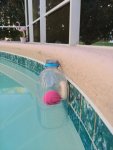I've been working toward having more control over my pool in my absence, largely to avoid the need to get someone to intervene for me when I'm away. I've finally got to the point where I can monitor my pump performance, SWG performance, pool water level and pool water clarity. All that helps greatly. The remaining thing that often needs intervention is adjusting water level, especially draining water after major storms so common in Florida.
I'm thinking about adding a remote control valve on my drain port that's now a manual faucet. This would allow me to be control it remotely and simply use real-time camera monitoring of my water level as my feedback. I was thinking of using a Wzye smart switch that would power a powerpack that would power a valve. This would allow me to use my present home automation system for this purpose and avoid the need for a separate system and app. I thought an irrigation valve might work but they're not recommended for this type of service and they are typically installed below ground. There are other styles of control valves I could use but they're typically more expensive and I don't know how reliable they are. Taking this one step further I could also add a second valve that would connect my home water supply to the pump plumbing so I could back-feed it to add water when needed.
Is this a reasonable approach? Can standard plastic irrigation valves be mounted above ground and would they survive the Florida heat and sun? Any other methods I should consider?
I'm thinking about adding a remote control valve on my drain port that's now a manual faucet. This would allow me to be control it remotely and simply use real-time camera monitoring of my water level as my feedback. I was thinking of using a Wzye smart switch that would power a powerpack that would power a valve. This would allow me to use my present home automation system for this purpose and avoid the need for a separate system and app. I thought an irrigation valve might work but they're not recommended for this type of service and they are typically installed below ground. There are other styles of control valves I could use but they're typically more expensive and I don't know how reliable they are. Taking this one step further I could also add a second valve that would connect my home water supply to the pump plumbing so I could back-feed it to add water when needed.
Is this a reasonable approach? Can standard plastic irrigation valves be mounted above ground and would they survive the Florida heat and sun? Any other methods I should consider?







